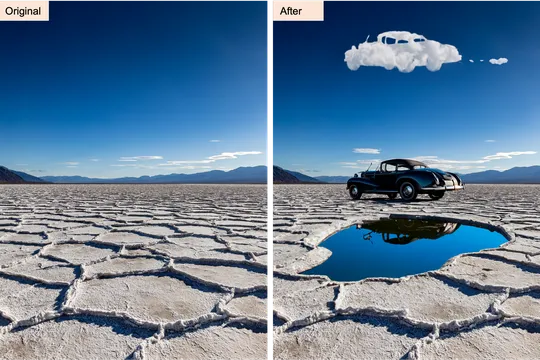Adobe will incorporate generative AI images into Photoshop, which the company labels a ‘co-pilot’ for graphic designers, rather than a replacement of them.
The ‘Generative Fill’ mode is branded Adobe Firefly, launching over a month ago in a beta version and will be officially released later this year. It operates similar to Dall E 2 and Midjourney, using text prompts to generate AI images. Although this goes a step further, as users can then add various Photoshop adjustments and edits.
For instance, Photoshop users can use Generative Fill mode for ‘outpainting’ – expanding the image beyond its borders with matching elements. Or generate entirely new objects, which are handled through Photoshop via layers.
Adobe claims to have trained this AI on content the company has a right to use, such as Adobe Stock images and public domain images. This means that creators can, in theory, go about their AI content creation without the stomach-churning feeling that the tool is created by violating the copyright of millions of people.
Here’s some dot points put together by Adobe to promote Firefly:
– Powered by Firefly: Firefly is designed to generate images that are safe for commercial use and is trained on Adobe Stock’s hundreds of millions of professional-grade, licensed, high-resolution images, helping ensure Firefly won’t generate content based on other peoples’ or brands’ intellectual property (IP);
– Magically leap from idea to image, with simple text prompts: Add, extend or remove content from images to achieve astounding results;
– Edit non-destructively: Create newly generated content in generative layers, enabling you to exhaust a myriad of creative possibilities and reverse the effects when you want, without impacting your original image;
– Create at a transformative rate: Experiment with off-the-wall ideas, ideate different concepts and produce boundless variations of high-quality content as fast as you can type;
– Available as a web tool: Generative Fill is also available as a new module in the Firefly beta for users interested in testing the new capabilities on the web.
It seems inevitable Adobe would eventually integrate an AI image generator into its software suite. The company has focussed on AI-powered editing tools for some time, and ‘generative AI systems’ are currently dominating the technical innovation discussion.
By embracing the non-human creator, Adobe may be in danger of cannibalisation. There is concern that AI image generators will impact the careers of professional photographers and graphic designers, who make up a large portion of Adobe’s customers.
If these professionals are replaced by AI image systems, they’ll have no need to pay for a Creative Cloud subscription.
Although director of digital media and strategy for Adobe Asia-Pacific, Chandra Sinnathamby, told The Guardian Generative Fill will help creators, not hinder their future viability.
‘The whole idea is: how do we help that creative accelerate, and that content creation at scale, with precision and speed?’ he said. ‘Most campaigns you have to collaborate with various different things. So we how do we accelerate that collaboration process?’
Adobe is also pushing its Content Authenticity Initiative (CAI), an initiative it launched in 2019 with Twitter and New York Times to fight misinformation. The CAI aims to create a more secure photo metadata that adds a certification showing the image source and edits. The initiative was launched before the emergence of AI image generators, which are now undoubtedly of considerable interest to the group.
Adobe’s Generative Fill supports ‘Content Credentials’, a CAI development that has ‘an essential role in ensuring people know whether a piece of content was created by a human, AI-generated or AI-edited’.
‘Content Credentials or “nutrition labels” for digital content remain associated with content wherever it is used, published or stored, enabling proper attribution and helping consumers make informed decisions about digital content,’ the press release states.
Stock photographers who have contributed to the AI library are also apparently identified and paid when their work is used. It’s not disclosed how though. Adobe Stock contributors also haven’t been notified of a payment structure.





Be First to Comment